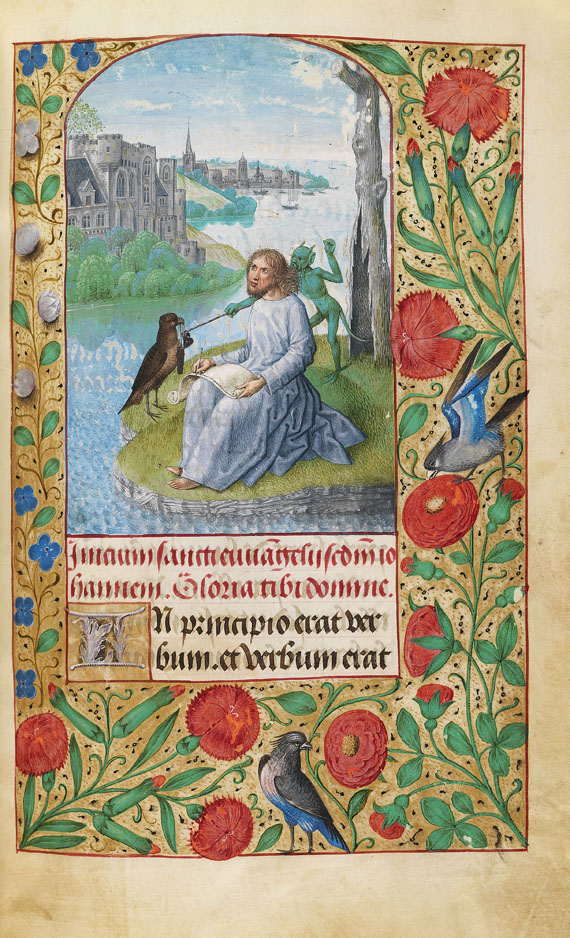Altre immagini
Altre immagini
Altre immagini
Altre immagini
Altre immagini
Altre immagini
Altre immagini
Altre immagini
Altre immagini
Altre immagini
Altre immagini
Altre immagini
Altre immagini
Altre immagini
Altre immagini
Altre immagini
Altre immagini

6
Manuskript
Stundenbuch auf Pergament. Flandern um 1500.
Stima:
€ 250,000 / $ 292,500 Risultato:
€ 424,800 / $ 497,015 ( commissione inclusa)
Das De Gros-Carondelet-Stundenbuch. - Latin book of hours, use of Rome. Manuscript on very delicate vellum. Flanders around 1480 as well as Burgundy around 1500 348 ll. Size 20,8 : 14,2 cm. Justification 11,4 : 7,1 cm. Flemish Bastarda in black ink, rubrics in red. 16 (text) and 17 (calendar) lines respectively, slugged in red. With illuminations by Simon Marmion , the Dresden master of prayer books and further painters from the circle, additionally, by an unknown French master: 22 full-page miniatures with surrounding border of various leaves, flowers, fruits, birds, etc. and with three-line initial in colors below, with 6 small miniatures (ca. 4,5 : 4,5 cm) as well as numerous two- and one-line white-heightened initials in gray blue on gilt-heightened red brown ground and line fillers in same make. – Contemp. Flemish calf binding over blind-tooled wooden boards: Each board with 8 board stamps separated by friezes, each plate consists of two rows of vine scrolls with 3 animals each and circumscription ‘Adiutorium nostrum in nomine domini qui fecit celum et terram bzw. sit nomen domini benedictum et hoch nunc et usq(ue) in seculum‘ (cf. Luc Indestege, Schmuckformen auf flämischen Einbänden, in: Gutenberg-Jb. 33, 1958, pp. 279 and 281, nos. 24-27 and 54, with identical circumscriptions, however, different size). Gatherings of twelve all the way through (except for first and last gathering), partly with catchwords.
High quality illuminated vellum manuscript of outmostly noble make and provenance , at the same time a prime historic document from the inner circle of the Burgundian court’s last period. The magnificently preserved manuscript shows the unique development from an originally Flemish to a later French style. Initially designed for the Burgundian secretary Jean III. de Gros (1434-1484) around 1480, and illuminated by Simon Marmion, the Dresden prayer book master and other painters, the manuscript went into the ownership of the Burgundian chancellor Jean I. Carondelet and his family some twenty years later. In context of this change of ownership, which may have partly been politically motivated, the miniatures as well as the borders were entirely worked over and modernized by a French book painter, which led to the fascinating synthesis of Flemish and French stylistic elements. “The apparently complete ‘Redecoration’ of the illuminations just a few years after the commissioned manuscript was actually made is so unique that it causes one to speculate whether it was simply motivated by aesthetic reasons or if perhaps treason of the previous owner may have been the actual reason. Whatever the reason, as far as I am concerned, this work is unique considering the aspect of the illuminations.“ (B. Brinkmann).
High quality illuminated vellum manuscript of outmostly noble make and provenance , at the same time a prime historic document from the inner circle of the Burgundian court’s last period. The magnificently preserved manuscript shows the unique development from an originally Flemish to a later French style. Initially designed for the Burgundian secretary Jean III. de Gros (1434-1484) around 1480, and illuminated by Simon Marmion, the Dresden prayer book master and other painters, the manuscript went into the ownership of the Burgundian chancellor Jean I. Carondelet and his family some twenty years later. In context of this change of ownership, which may have partly been politically motivated, the miniatures as well as the borders were entirely worked over and modernized by a French book painter, which led to the fascinating synthesis of Flemish and French stylistic elements. “The apparently complete ‘Redecoration’ of the illuminations just a few years after the commissioned manuscript was actually made is so unique that it causes one to speculate whether it was simply motivated by aesthetic reasons or if perhaps treason of the previous owner may have been the actual reason. Whatever the reason, as far as I am concerned, this work is unique considering the aspect of the illuminations.“ (B. Brinkmann).
6
Manuskript
Stundenbuch auf Pergament. Flandern um 1500.
Stima:
€ 250,000 / $ 292,500 Risultato:
€ 424,800 / $ 497,015 ( commissione inclusa)




 Lot 6
Lot 6